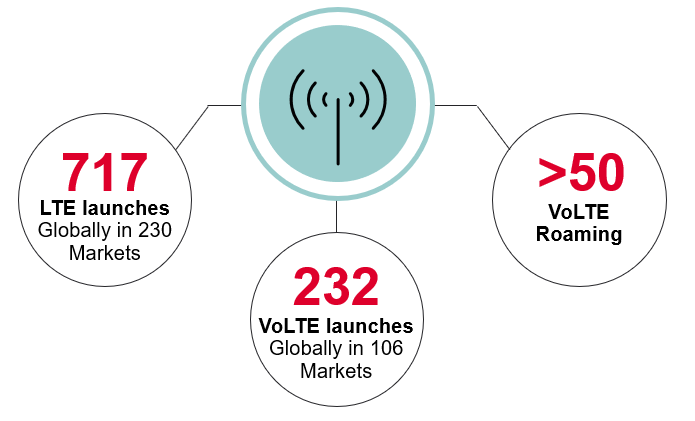While VoLTE is now widespread and commonly deployed, a significant majority of mobile network operators are yet to launch it, and VoLTE roaming lags behind further still. At the time of writing, there are 717 LTE networks launched globally across 230 markets. Of those LTE networks, 232 have also launched VoLTE in over 106 markets. Of the 232 VoLTE network operators, only around 50 have also launched VoLTE roaming.

VoLTE and spectrum refarming
With the advent of 5G came the need to re-farm existing 2G/3G spectrum for new 5G services. This can only be done when legacy 2G/3G services have been replaced by alternative options. For voice telephony, this means replacing 2G/3G based voice with VoLTE. There is therefore a pressing need for both VoLTE and VoLTE Roaming deployments to be significantly increased in order to replace legacy voice services and retire obsolete network equipment.
The impact of losing confidence in VoLTE
Some of the earlier VoLTE launches encountered devices that inhibited VoLTE functionality on networks they hadn’t performed 1:1 testing with. Typically, the device checks the network identity through the SIM, to see whether the network is on its approved/tested list or not.
With the industry set to explode with a multitude of services reliant on VoLTE and 5G capability, GSMA has introduced a practical solution to boost the confidence of operators and manufacturers. We are supporting the growth in VoLTE device and network compatibility, both at home and also when roaming.
GSMA Interoperability Testing promotes VoLTE compatibility
Based on recommendations made by the GSMA Networks Group and documented in PRD IR.25, GSMA has recently launched an interoperability testing service to enable VoLTE testing of devices and networks. Four different tests are offered:
• Network Test
• Network Roaming Test
• Combined Network & Device Test
• Device Test (specifically for OEMs)
The testing focusses on IMS settings and the related configuration parameters, as defined in GSMA PRD TS.32 and uploaded to the GSMA Network Settings Exchange database.
Network tests are carried out using the preferred IMS settings of the network (“IMS Profile”), while devices are tested against six different IMS profiles.
Successfully tested networks and devices will be published on GSMA.com and communicated to GSMA Network Settings Exchange subscribers, so that all participating operators and manufacturers can advertise their compliance. Thereby instilling confidence and reducing the effort for all manufacturers and operators to get in touch on an individual basis.
GSMA PRD TS.59 and Open Market Devices
The GSMA Terminal Steering Group published TS.59 (“Device Type Naming Requirements”) to provide specific guidance for Open Market Devices (OMD). TS.59 helpfully suggests that where ‘devices and networks have obtained GSMA certification of compliance with IR.25’, OMDs should not need to prevent any IMS services on a device when a network:
• has been successfully tested against the standards documented in PRD IR.25
• uses an IMS profile already tested/supported by the device
Therefore, I recommend that all operators wishing to mitigate any OEM’s lack of confidence in their VoLTE offering, should select an IMS profile likely to be supported by OEMs. Then pass the relevant tests our new Interoperability Testing service offers. Furthermore, MNOs that have yet to launch VoLTE should select one of the six IMS Profiles defined by the GSMA Networks Group.
Summary
Successful testing of networks and devices via GSMA Interoperability Testing, and significantly the promotion of these results to the industry, will boost everyone’s confidence in VoLTE and VoLTE roaming. Helpfully, it also means there’s no need for anyone to undertake bespoke 1:1 testing between all networks and TS.59-compliant OMDs. Such mitigation will instil confidence in the industry and facilitate the rollout of additional VoLTE deployments.
If you would like to find out more about GSMA Interoperability Testing, please get in touch here.
This blog was written by Wayne Cutler, GSMA’s interoperability solutions expert and GSMA’s Interoperability Testing Product Manager.

